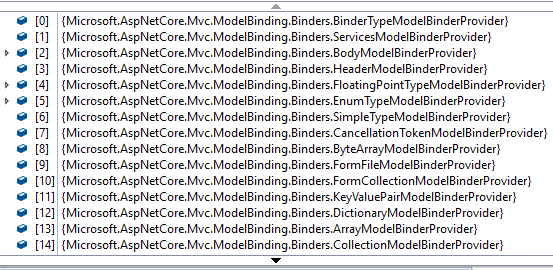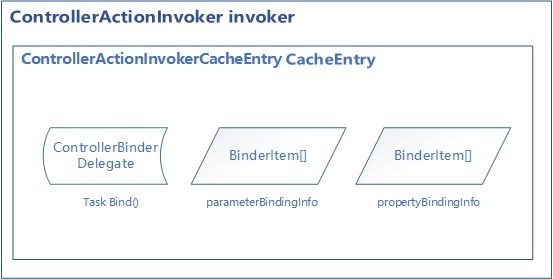十九. Action参数的映射与模型绑定
前文说道了Action的激活,这里有个关键的操作就是Action参数的映射与模型绑定,这里即涉及到简单的string、int等类型,也包含Json等复杂类型,本文详细分享一下这一过程。
# 1. 概述
当客户端发出一个请求的时候,参数可能存在于URL中也可能是在请求的Body中,而参数类型也大不相同,可能是简单类型的参数,如字符串、整数或浮点数,也可能是复杂类型的参数,比如常见的Json、XML等,这些事怎么与目标Action的参数关联在一起并赋值的呢?
故事依然是发生在通过路由确定了被请求的Action之后,invoker的创建与执行阶段(详见Action的执行 (opens new window))。
invoker的创建阶段,创建处理方法,并根据目标Action的actionDescriptor获取到它的所有参数,分析各个参数的类型确定对应参数的绑定方法,
invoker的执行阶段,调用处理方法,遍历参数逐一进行赋值。
为了方便描述,创建一个测试Action如下,它有两个参数,下文以此为例进行描述。:
public JsonResult Test([FromBody]User user,string note = "FlyLolo")
{
return new JsonResult(user.Code + "|" + user.Name );
}
2
3
4
# 2. 准备阶段
# 1. 创建绑定方法
当收到请求后,由路由系统确定了被访问的目标Action是我们定义的Test方法, 这时进入invoker的创建阶段,前文说过它有一个关键属性cacheEntry是由多个对象组装而成(发生在ControllerActionInvokerCache的GetCachedResult方法中),其中一个是propertyBinderFactory:
var propertyBinderFactory = ControllerBinderDelegateProvider.CreateBinderDelegate(_parameterBinder,_modelBinderFactory,_modelMetadataProvider,actionDescriptor,_mvcOptions);
看一下CreateBinderDelegate这个方法:
public static ControllerBinderDelegate CreateBinderDelegate(ParameterBinder parameterBinder,IModelBinderFactory modelBinderFactory,
IModelMetadataProvider modelMetadataProvider, ControllerActionDescriptor actionDescriptor, MvcOptions mvcOptions)
{
//各种验证 略
var parameterBindingInfo = GetParameterBindingInfo(modelBinderFactory, modelMetadataProvider, actionDescriptor, mvcOptions);
var propertyBindingInfo = GetPropertyBindingInfo(modelBinderFactory, modelMetadataProvider, actionDescriptor);
if (parameterBindingInfo == null && propertyBindingInfo == null)
{
return null;
}
return Bind;
async Task Bind(ControllerContext controllerContext, object controller, Dictionary<string, object> arguments)
{
//后文详细描述
}
}
2
3
4
5
6
7
8
9
10
11
12
13
14
15
16
17
18
前文说过,invoker的创建阶段就是创建一些关键对象和一些用于执行的方法,而propertyBinderFactory 就是众多方法之中的一个,前文介绍它是一个用于参数绑定的Task,而没有详细说明,现在可以知道它被定义为一个名为Bind的Task,最终作为invoker的一部分等待被执行进行参数绑定。
# 2. 为每个参数匹配Binder
上面的CreateBinderDelegate方法创建了两个对象parameterBindingInfo 和propertyBindingInfo ,顾名思义,一个用于参数一个用于属性。看一下parameterBindingInfo 的创建:
private static BinderItem[] GetParameterBindingInfo(IModelBinderFactory modelBinderFactory,IModelMetadataProvider modelMetadataProvider,ControllerActionDescriptor actionDescriptor, MvcOptions mvcOptions)
{
var parameters = actionDescriptor.Parameters;
if (parameters.Count == 0)
{
return null;
}
var parameterBindingInfo = new BinderItem[parameters.Count];
for (var i = 0; i < parameters.Count; i++)
{
var parameter = parameters[i];
//略。。。
var binder = modelBinderFactory.CreateBinder(new ModelBinderFactoryContext
{
BindingInfo = parameter.BindingInfo,
Metadata = metadata,
CacheToken = parameter,
});
parameterBindingInfo[i] = new BinderItem(binder, metadata);
}
return parameterBindingInfo;
}
2
3
4
5
6
7
8
9
10
11
12
13
14
15
16
17
18
19
20
21
22
23
24
可以看到parameterBindingInfo 本质是一个BinderItem[]
private readonly struct BinderItem
{
public BinderItem(IModelBinder modelBinder, ModelMetadata modelMetadata)
{
ModelBinder = modelBinder;
ModelMetadata = modelMetadata;
}
public IModelBinder ModelBinder { get; }
public ModelMetadata ModelMetadata { get; }
}
2
3
4
5
6
7
8
9
10
11
12
通过遍历目标Action的所有参数actionDescriptor.Parameters,根据参数逐一匹配一个对应定的处理对象BinderItem。
如本例,会匹配到两个Binder:
参数 user ===> {Microsoft.AspNetCore.Mvc.ModelBinding.Binders.BodyModelBinder}
参数 note ===> {Microsoft.AspNetCore.Mvc.ModelBinding.Binders.SimpleTypeModelBinder}
这是如何匹配的呢,系统定义了一系列provider,如下图

图一
会遍历他们分别与当前参数做匹配:
for (var i = 0; i < _providers.Length; i++)
{
var provider = _providers[i];
result = provider.GetBinder(providerContext);
if (result != null)
{
break;
}
}
2
3
4
5
6
7
8
9
同样以这两个Binder为例看一下,BodyModelBinderProvider:
public IModelBinder GetBinder(ModelBinderProviderContext context)
{
if (context == null)
{
throw new ArgumentNullException(nameof(context));
}
if (context.BindingInfo.BindingSource != null &&
context.BindingInfo.BindingSource.CanAcceptDataFrom(BindingSource.Body))
{
if (_formatters.Count == 0)
{
throw new InvalidOperationException(Resources.FormatInputFormattersAreRequired(
typeof(MvcOptions).FullName,
nameof(MvcOptions.InputFormatters),
typeof(IInputFormatter).FullName));
}
return new BodyModelBinder(_formatters, _readerFactory, _loggerFactory, _options);
}
return null;
}
2
3
4
5
6
7
8
9
10
11
12
13
14
15
16
17
18
19
20
21
22
23
BodyModelBinder的主要判断依据是BindingSource.Body 也就是user参数我们设置了[FromBody]。
同理SimpleTypeModelBinder的判断依据是 <span style="color: #0000ff;">if (!context.Metadata.IsComplexType) 。
找到对应的provider后,则会由该provider来new 一个 ModelBinder返回,也就有了上文的BodyModelBinder和SimpleTypeModelBinder。
小结:至此前期准备工作已经完成,这里创建了三个重要的对象:
1. Task Bind() ,用于绑定的方法,并被封装到了invoker内的CacheEntry中。
2. parameterBindingInfo :本质是一个BinderItem[],其中的BinderItem数量与Action的参数数量相同。
3. propertyBindingInfo:类似parameterBindingInfo, 用于属性绑定,下面详细介绍。

图二
# 3. 执行阶段
从上一节的小结可以猜到,执行阶段就是调用Bind方法,利用创建的parameterBindingInfo和propertyBindingInfo将请求发送来的参数处理后赋值给Action对应的参数。
同样,这个阶段发生在invoker(即ControllerActionInvoker)的InvokeAsync()阶段,当调用到它的Next方法的时候,首先第一步State为ActionBegin的时候就会调用BindArgumentsAsync()方法,如下
private Task Next(ref State next, ref Scope scope, ref object state, ref bool isCompleted)
{
switch (next)
{
case State.ActionBegin:
{
//略。。。
_arguments = new Dictionary<string, object>(StringComparer.OrdinalIgnoreCase);
var task = BindArgumentsAsync();
}
2
3
4
5
6
7
8
9
10
11
而BindArgumentsAsync()方法会调用上一节创建的_cacheEntry.ControllerBinderDelegate,也就是Task Bind() 方法
private Task BindArgumentsAsync()
{
// 略。。。
return _cacheEntry.ControllerBinderDelegate(_controllerContext, _instance, _arguments);
}
2
3
4
5
6
上一节略了,现在详细看一下这个方法,
async Task Bind(ControllerContext controllerContext, object controller, Dictionary<string, object> arguments)
{
var valueProvider = await CompositeValueProvider.CreateAsync(controllerContext);
var parameters = actionDescriptor.Parameters;
for (var i = 0; i < parameters.Count; i++) //遍历参数集和,逐一处理
{
var parameter = parameters[i];
var bindingInfo = parameterBindingInfo[i];
var modelMetadata = bindingInfo.ModelMetadata;
if (!modelMetadata.IsBindingAllowed)
{
continue;
}
var result = await parameterBinder.BindModelAsync(
controllerContext,
bindingInfo.ModelBinder,
valueProvider,
parameter,
modelMetadata,
value: null);
if (result.IsModelSet)
{
arguments[parameter.Name] = result.Model;
}
}
var properties = actionDescriptor.BoundProperties;
for (var i = 0; i < properties.Count; i++)
//略
}
2
3
4
5
6
7
8
9
10
11
12
13
14
15
16
17
18
19
20
21
22
23
24
25
26
27
28
29
30
31
32
33
34
主体就是两个for循环,分别用于处理参数和属性,依然是以参数处理为例说明。
依然是先获取到Action所有的参数,然后进入for循环进行遍历,通过parameterBindingInfo[i]获取到参数对应的BinderItem,这些都准备好后调用parameterBinder.BindModelAsync()方法进行参数处理和赋值。注意这里传入了 bindingInfo.ModelBinder ,在parameterBinder中会调用传入的modelBinder的BindModelAsync方法
modelBinder.BindModelAsync(modelBindingContext);
而这个modelBinder是根据参数匹配的,也就是到现在已经将被处理对象交给了上文的BodyModelBinder、SimpleTypeModelBinder等具体的ModelBinder了。
以BodyModelBinder为例:
public async Task BindModelAsync(ModelBindingContext bindingContext)
{
//略。。。
var formatterContext = new InputFormatterContext(httpContext,modelBindingKey,bindingContext.ModelState, bindingContext.ModelMetadata, _readerFactory, allowEmptyInputInModelBinding);
var formatter = (IInputFormatter)null;
for (var i = 0; i < _formatters.Count; i++)
{
if (_formatters[i].CanRead(formatterContext))
{
formatter = _formatters[i];
_logger?.InputFormatterSelected(formatter, formatterContext);
break;
}
else
{
_logger?.InputFormatterRejected(_formatters[i], formatterContext);
}
}
var result = await formatter.ReadAsync(formatterContext);
//略。。。
}
2
3
4
5
6
7
8
9
10
11
12
13
14
15
16
17
18
19
20
21
22
23
24
25
部分代码已省略,剩余部分可以看到,这里像上文匹配provider一样,会遍历一个名为_formatters的集和,通过子项的CanRead方法来确定是否可以处理这样的formatterContext。若可以,则调用该formatter的ReadAsync()方法进行处理。这个_formatters集和默认有两个Formatter, Microsoft.AspNetCore.Mvc.Formatters.JsonPatchInputFormatter} 和 Microsoft.AspNetCore.Mvc.Formatters.JsonInputFormatter , JsonPatchInputFormatter的判断逻辑是这样的
if (!typeof(IJsonPatchDocument).GetTypeInfo().IsAssignableFrom(modelTypeInfo) ||
!modelTypeInfo.IsGenericType)
{
return false;
}
2
3
4
5
它会判断请求的类型是否为IJsonPatchDocument,JsonPatch见本文后面的备注,回到本例,我们经常情况遇到的还是用JsonInputFormatter,此处它会被匹配到。它继承自TextInputFormatter , TextInputFormatter 又继承自 InputFormatter,JsonInputFormatter未重写CanRead方法,采用InputFormatter的CanRead方法。
public virtual bool CanRead(InputFormatterContext context)
{
if (SupportedMediaTypes.Count == 0)
{
var message = Resources.FormatFormatter_NoMediaTypes(GetType().FullName, nameof(SupportedMediaTypes));
throw new InvalidOperationException(message);
}
if (!CanReadType(context.ModelType))
{
return false;
}
var contentType = context.HttpContext.Request.ContentType;
if (string.IsNullOrEmpty(contentType))
{
return false;
}
return IsSubsetOfAnySupportedContentType(contentType);
}
2
3
4
5
6
7
8
9
10
11
12
13
14
15
16
17
18
19
20
例如要求ContentType不能为空。本例参数为 [FromBody]User user ,并标识了 content-type: application/json ,通过CanRead验证后,
public override async Task<InputFormatterResult> ReadRequestBodyAsync(InputFormatterContext context,Encoding encoding)
{
//略。。。。using (var streamReader = context.ReaderFactory(request.Body, encoding))
{
using (var jsonReader = new JsonTextReader(streamReader))
{
jsonReader.ArrayPool = _charPool;
jsonReader.CloseInput = false;
//略。。var type = context.ModelType;
var jsonSerializer = CreateJsonSerializer();
jsonSerializer.Error += ErrorHandler;
object model;
try
{
model = jsonSerializer.Deserialize(jsonReader, type);
}
//略。。。
}
}
}
2
3
4
5
6
7
8
9
10
11
12
13
14
15
16
17
18
19
20
21
可以看到此处就是将收到的请求的内容Deserialize,获取到一个model返回。此处的jsonSerializer是 Newtonsoft.Json.JsonSerializer ,系统默认采用的json处理组件是Newtonsoft。model返回后,被赋值给对应的参数,至此赋值完毕。
小结:本阶段的工作是获取请求参数的值并赋值给Action的对应参数的过程。由于参数不同,会分配到一些不同的处理方法中处理。例如本例涉及到的provider(图一)、不同的ModelBinder(BodyModelBinder和SimpleTypeModelBinder)、不同的Formatter等等,实际项目中还会遇到其他的类型,这里不再赘述。
而文中有两个需要单独说明的,在后面的小节里说一下。
# 4. propertyBindingInfo
上文提到了但没有介绍,它主要用于处理Controller的属性的赋值,例如:
public class FlyLoloController : Controller
{
[ModelBinder]
public string Key { get; set; }
//other ...
}
2
3
4
5
6
7
有一个属性Key被标记为[ModelBinder],它会在Action被请求的时候,像给参数赋值一样赋值,处理方式也类似,不再描述。
# 5. JsonPatch
上文中提到了JsonPatchInputFormatter,简要说一下JsonPatch,可以理解为操作json的文档,比如上文的User类是这样的:
public class User
{
public string Code { get; set; }
public string Name { get; set; }
//other ...
}
2
3
4
5
6
7
现在我只想修改它的Name属性,默认情况下我仍然会需要提交这样的json
{"Code":"001","Name":"张三", .........}
这不科学,从省流量的角度来说也觉得太多了,用JsonPatch可以这样写
[
{ "op" : "replace", "path" : "/Name", "value" : "张三" }
]
2
3
